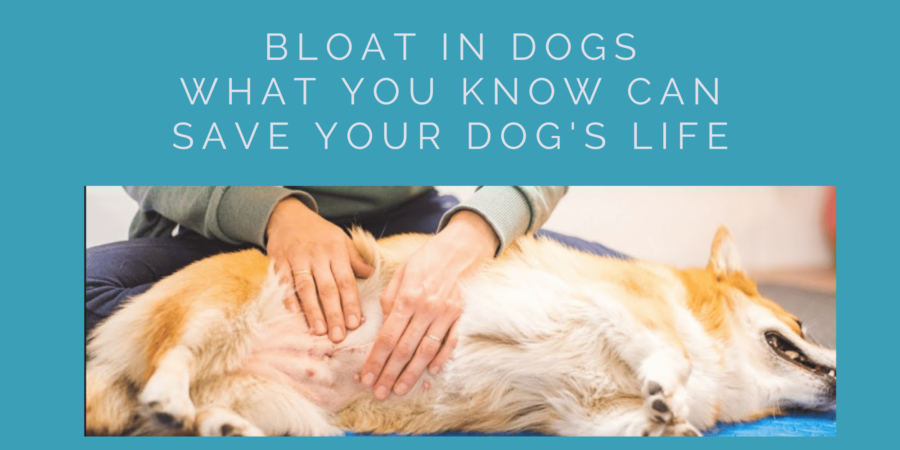In the last month, I’ve read four posts in different FB groups I belong to where people are crushed with grief having lost their dogs, one as young as 9 months, to the dreaded medical emergency, commonly known as bloat, or the medical term gastric dilatation volvulus, or GDV. What makes this more earth shattering is that bloat is pretty much preventable, and yet most people are completely unaware of what this medical and surgical emergency is all about until it happens to their dog.
I’ve owned dogs for over 30 years, and bloat can happen to any dog, but it most commonly occurs in deep-chested dogs, such as the Great Dane, St. Bernard, Weimaraner, Irish Setters, German Shepherds, Dobermans. It’s when the height of the dog is greater than its width.

Bloat is when gas and air buildup, and as the abdomen expands, it presses on other organs, for example, the pancreas, which constrict and stops the blood flow back to the heart, sending your dog into systemic shock. At the same time, the stomach flips, causing further pressure on organs, which can cause the dog to collapse. Bloat is extremely painful for a dog, and unless you get the dog immediately to the vet, there’s an extremely good chance your dog will die.
Now what does bloat look like? How will you know your dog has it?
Well, you’re going to notice that your dog looks miserable, and you may be able to tell the dog’s abdomen is distended, and painful to the dog if you touch it. The dog may be salivating, drooling, nauseous, trying to retch and vomit, but nothing is happening. If you touch the dog, he may be whining and crying.

Now if you see this happening, you drop everything, you call the immediately, tell them what’s happening, and you rush your dog into the vet. You don’t change clothes, you don’t put your makeup on, you don’t phone five people – you can call them from the car. Time is of the essence, because depending on when you noticed your dog’s symptoms, your dog can be dead in an hour.
So what can cause bloat in dogs and how can you prevent it? Let’s look at some of the causes first.
- Diet. Kibble that is high in fat content, where fats are listed as one of the first four ingredients in dog food rather than a protein such as beef, chicken can be a cause.
- Feeding your dog only once a day, instead of minimum twice a day can be a contributing factor because of the amount of food the dog intakes.
- If your dog is a fast eater, and/or has a high strung, nervous temperament.
- The dog running around immediately after eating. While some mild exercise may not be harmful, say the dog walks around the backyard or trots up to the fence, which is entirely the opposite of having your dog run around the backyard playing fetch the ball, jumping into a swimming pool, or running and jumping in general. NOT a good idea.
What can you do to prevent it?
- First, if you do feed your dog kibble, make sure the kibble’s ingredient label lists meat protein first, such as beef, lamb, chicken, or others.
- I feed twice/day, and for my Shepherds, both are between 82 and 96 lbs, they get 1-1/2 cups of dry food, plus I mix in about 1/3 cup of wet canned food, and add 1/3-1/2 cup of water on top of that. By adding some water to your dog’s food bowl, it helps prevent them from taking long drinks of water after they eat.
- If your dog has been active outside, playing running around, etc., when they come inside, wait about 30 minutes to an hour before feeding them. After your dogs have finished their meal, have them rest quietly for another hour. Again, no running around.
- If you have a fast eater, which I have two, get one of those dog puzzle bowls that slows down their eating.

What if your dog has bloat or you suspect it does?
Call the vet, tell them you suspect bloat and then get your dog to the vet as fast as possible. Do not “wait and see,” call a family member/friend for advice, or “wait it out” because if your dog does have bloat, it can literally be dead in about 1-2 hours. Once you’re at the vet, and if it is bloat, the vet will immediately try and stabilize the dog from shock, and then once stabilized, perform surgery. Now, be aware, that even with the surgery, your dog can still die. And be aware that this surgery is going to be thousands of dollars as all surgeries are.
So please be incredibly careful with your pups. For more information, here is a link to a YouTube video on bloat by Dr. Andrew Jones, “Bloat in Dogs: Signs to Watch For, What To Do“.
Discover more from The Pup Mommy
Subscribe to get the latest posts sent to your email.






Leave a Reply